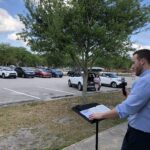VERO BEACH — Following a five-year effort, and a $1.6 million outlay, Vero’s Community Church has a new pipe organ, having donated the organ it used for 14 years to a United Methodist congregation in Edmonds, Washington.
The old organ, its 2,200 pipes intended for the Vero church’s former sanctuary that seated 300, was moved into the enlarged 1,000-person space with disappointing results.
Attempts to enlarge it were not successful. At that point, the organ was put up for sale, at $275,000, and the Washington congregation expressed interest. But with an economic downturn, the Edmonds church couldn’t afford it and with some dissent, the Community Church voted to give the organ away.
The new organ was part of a $12.3 million renovation undertaken by the church, despite a chastening economic scenario locally, to accommodate its expanding congregation, now at more than 2,000.
The new organ’s components began arriving in February, with the façade pipes shipped later from Holland, and took five weeks to assemble. Since then, the makers of the organ have been “voicing” the instrument’s 4,000 pipes, in response to the room in which it will be played.
To make the most of the room-sized beast of an instrument, the sanctuary required substantial changes. Acoustical adjustments included a retractable curtain on the wall opposite the organ’s pipes, various sound diffusers, and the replacement of carpeting with tile flooring. In addition, the ceiling had to be raised to accommodate 35-foot tall pipes. And the stained glass window known as the “Christ window,” made by Vero’s Conrad Pickel Studio, had to be moved.
On a recent Sunday, the organ’s makers, Mark Lively and Paul Fulcher, of Alexandria, Virginia, spoke to a small group who stayed after services for a lecture-demonstration of the instrument. While Mark Lively elucidated the history, science and mathematics behind the various mechanisms involved in the organ’s sound production, Community Church’s music director, Jose Daniel Flores, demonstrated on the keyboard, and in the end, delivered a brief concert demonstrating the vast range of the instrument.
“I will not speak much about the organ,” Flores told the gathering prior to playing. “The organ speaks for itself.”
Whereas before, the organ stood to one side, the new organ now takes center stage in the church’s chancel, the raised area that includes the pulpit and choir. Its largest pipes rise like trees in a forest surrounding the yellow light of the Christ window.
Those pipes, and the assemblage of three keyboards and foot pedals played by Flores, are only a fraction of the instrument; the rest of its 4083 pipes — some made of metal for a bright sound, some wooden for mellow notes, some made with reeds, or stopped at the top for a flute-like, rounder tone — fill a large room behind the wooden façade.
The organ is entirely mechanical – no part is electronic, except for the giant compressors that power the bellows blowing wind past each pipes’ base, where it rises and exits through the narrow slit called the flue and causes the rest of the tall pipe above to resonate.
The erected pipes are interlaced with a grid of walkways between them for easy access for adjustments and repair. Once installed, the organ is expected to last 200 years or more, Lively says.
Lively enumerated the sections of pipe like divisions of an orchestra, each mimicking the roles of instruments, from tinkling bells to thunderous tuba, and even the ancient “voix humaine”, that emulates the human voice.
“Many colors, or sounds, are hundreds of years old, developed for the music of that era,” said Lively, “so that Jose Daniel can find everything he needs.”
It is the stops, manipulated by the keyboardist, which determine through an elaborate system of magnets and sliders , which pipes the air will pass by, and at what force, determining their volume.
Some keys may cause as many as five pipes to sound at once, as in the collection for a solo cornet, a very ancient sound, Lively pointed out. “In those days, along with the church clock, the pipe organ was the most high-tech thing known to humanity,” Lively said. “I tend to think not a lot has changed.”
For the past three months, Lively and Fulcher have been “voicing” the pipes – setting their tone, working with the room itself, a crucial part of the organ’s construction, they said. That followed a year of “prevoicing” the pipes in their Virginia workshop, where they made “educated guesses” as to how the pipes would sound installed.
“The organ, more than any other instrument, uses the acoustics of the room as its sounding board,” Lively told the group. “It’s our job to use this sounding board to the best of its ability. That can’t be done in a workshop.”
From the moment the pipes were installed last March, their work began. “We started to listen to the sounds, and the adjustments began. All of it is done by ear. There is no electronic equipment to help us guide our way.”
As Flores prepared to play a piece demonstrating the great range of the instruments from soft to loud, he pointed out that in the past, a full orchestra tended to overwhelm the smaller organ the church once held. “This will not be the case,” he said, lowering his voice with understatement to a broad chuckle from the audience.





